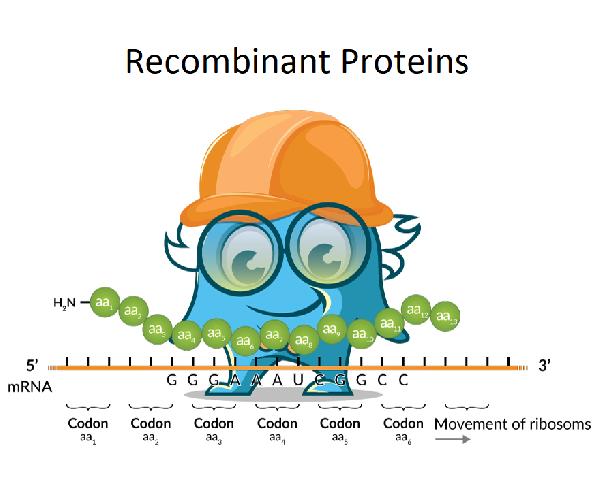Product Info Summary
| SKU: | PROTQ8TAD2 |
|---|---|
| Size: | 5ug, 25ug, 1mg |
| Origin Species: | Human |
| Source: | Escherichia coli |
Customers Who Bought This Also Bought
Product info
Product Name
IL17D Interleukin-17D Human Recombinant Protein
View all IL-17D recombinant proteins
SKU/Catalog Number
PROTQ8TAD2
Size
5ug, 25ug, 1mg
Description
Interleukin-17D Human Recombinant (18-202) produced in E. coli is a non-glycosylated disulfide-linked homodimer containing 2 polypeptide chains of 185 amino acids each and having a molecular mass of 40kDa. The IL-17D is purified by proprietary chromatographic techniques.
Storage & Handling
Lyophilized IL17D although stable at room temperature for 3 weeks, should be stored desiccated below -18°C. Upon reconstitution IL-17D should be stored at 4°C between 2-7 days and for future use below -18°C. For long term storage it is recommended to add a carrier protein (0.1% HSA or BSA). Please prevent freeze-thaw cycles.
Cite This Product
IL17D Interleukin-17D Human Recombinant Protein (Boster Biological Technology, Pleasanton CA, USA, Catalog # PROTQ8TAD2)
Form
Sterile Filtered White lyophilized (freeze-dried) powder.
Formulation
Lyophilized from a 0.2µm filtered solution in Acetonitrile and TFA.
Purity
Greater than 97.0% as determined by SDS-PAGE.
Predicted MW
21.893kDa
Reconstitution
It is recommended to reconstitute the lyophilized IL-17D in sterile 18M-cm H2O not less than 100µg/ml, which can then be further diluted to other aqueous solutions.
Amino Acid Sequence
APRAGRRPAR PRGCADRPEE LLEQLYGRLA AGVLSAFHHT LQLGPREQAR NASCPAGGRP ADRRFRPPTN LRSVSPWAYR ISYDPARYPR YLPEAYCLCR GCLTGLFGEE DVRFRSAPVY MPTVVLRRTP ACAGGRSVYT EAYVTIPVGC TCVPEPEKDA DSINSSIDKQ GAKLLLGPND APAGP
Biological Activity
Immobilized rHuIL-17D binds to rHuIL-17BR with EC50 less than 2µg/ml.
Assay dilution & Images
Reconstitution
It is recommended to reconstitute the lyophilized IL-17D in sterile 18M-cm H2O not less than 100µg/ml, which can then be further diluted to other aqueous solutions.
Validation Images & Assay Conditions

Click image to see more details
Recombinant protein fun image
Protein Target Info & Infographic
Gene/Protein Information For IL17D (Source: Uniprot.org, NCBI)
Gene Name
IL17D
Full Name
Interleukin-17D
Weight
21.893kDa
Superfamily
IL-17 family
Alternative Names
Interleukin 17D; Interleukin 27; IL-17D; IL-27; IL27; Interleukin-17D; Interleukin-27; IL17D IL17D IL-17D interleukin 17D interleukin-17D
*If product is indicated to react with multiple species, protein information is based on the gene entry specified above in "Species".For more info on IL17D, check out the IL17D Infographic

We have 30,000+ of these available, one for each gene! Check them out.
In this infographic, you will see the following information for IL17D: database IDs, superfamily, protein function, synonyms, molecular weight, chromosomal locations, tissues of expression, subcellular locations, post-translational modifications, and related diseases, research areas & pathways. If you want to see more information included, or would like to contribute to it and be acknowledged, please contact us at [email protected].
Specific Publications For IL17D Interleukin-17D Human Recombinant Protein (PROTQ8TAD2)
Hello CJ!
No publications found for PROTQ8TAD2
*Do you have publications using this product? Share with us and receive a reward. Ask us for more details.
Recommended Resources
Here are featured tools and databases that you might find useful.
- Boster's Pathways Library
- Protein Databases
- Bioscience Research Protocol Resources
- Data Processing & Analysis Software
- Photo Editing Software
- Scientific Literature Resources
- Research Paper Management Tools
- Molecular Biology Software
- Primer Design Tools
- Bioinformatics Tools
- Phylogenetic Tree Analysis
Customer Reviews
Have you used IL17D Interleukin-17D Human Recombinant Protein?
Submit a review and receive an Amazon gift card.
- $30 for a review with an image
0 Reviews For IL17D Interleukin-17D Human Recombinant Protein
Customer Q&As
Have a question?
Find answers in Q&As, reviews.
Can't find your answer?
Submit your question



